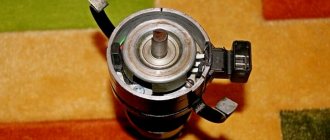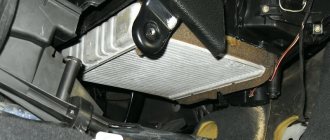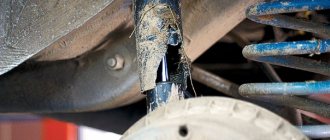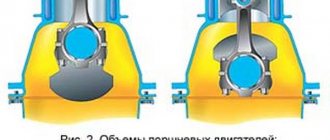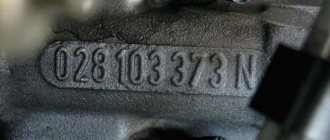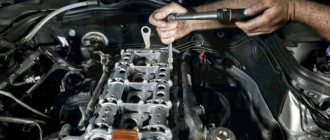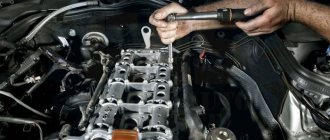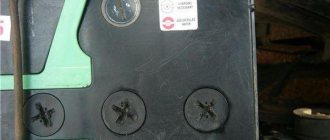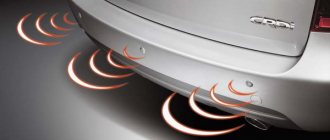Temperatures
This device works by monitoring changes in the input resistance of the medium being measured. When the coolant overheats, a special light on the instrument panel lights up. In addition, the device transmits information about the state of antifreeze to the vehicle's ECU. Based on the data received, the electronic system adjusts the composition of the air-fuel mixture.
The principle of operation of the device is to measure its internal resistance, which changes with the temperature of the coolant.
The following signs indicate a failure of the temperature sensor:
- increased fuel consumption;
- uncontrolled fan activation for no apparent reason;
- problems when starting a hot engine;
- lack of a working cooling fan due to an overheated motor.
Often the internal electrical contact in the device breaks or the wiring connecting the sensor and the computer is broken.
Design and principle of operation of the injector
Today, the injection (or, scientifically speaking, injection) engine has almost completely replaced outdated carburetor engines. An injection engine significantly improves the vehicle's performance and power performance (acceleration dynamics, environmental performance, fuel consumption).
Fuel injection systems have the following main advantages over carburetor systems:
- Precise fuel dosing and, therefore, more economical fuel consumption;
- Reducing exhaust toxicity. Achieved through optimal fuel-air mixture and the use of exhaust gas parameter sensors;
- An increase in engine power by approximately 7-10% due to improved cylinder filling, optimal setting of the ignition timing corresponding to the engine operating mode;
- Improving the dynamic properties of the car. The injection system immediately responds to any load changes, adjusting the parameters of the fuel-air mixture;
- Easy to start regardless of weather conditions.
DPKV
The device is located on the bottom of the cylinder block. The operation of the internal combustion engine directly depends on this sensor. Based on such data, the ECU supplies fuel and lights the spark plug for a specific cylinder.
If the sensor fails, then due to loss of synchronization the power unit simply stops working. In modern cars, the engine begins to function in emergency mode when the speed is limited.
When checking the device, you need to remove it. If it has mechanical damage, it must be replaced immediately. You can check the health of the sensor using a multifunction tester or an oscilloscope. Detonation, engine stalling, and unstable idling are important signs of DPKV malfunction.
All signs of a faulty crankshaft position sensor.
Good afternoon. In today's article, I have collected for you all the signs of a faulty crankshaft position sensor.
Traditionally for our site, the article contains many photos and video materials.
What is the crankshaft position sensor for and how does it work?
The crankshaft position sensor is used to determine the angle of rotation of the crankshaft at a given time.
This is the only sensor without which the engine will not work.
It looks like this:
If possible, you should take this sensor with you - it is not expensive, but it is not always on sale, especially in stores in remote areas.
The crankshaft position sensor works in conjunction with a timing disc on a pulley or flywheel. The sync disk looks like this:
The crankshaft position sensor itself is a wire coil on a magnetic core.
When the synchronization disk rotates, the metal plates periodically approach and separate from the core, due to this the magnetic field strength changes, and an electric current is induced in the sensor coil.
If we connect the output signal of the sensor to an oscilloscope, we will see this picture:
This signal is sent to the engine control unit, and it in turn issues commands to supply a spark to the cylinders and open the injectors.
Although the sensor is a simple device, since it operates under difficult conditions (vibration, temperature changes), it sometimes fails. It is known that a sensor malfunction is not always obvious.
Signs of a malfunctioning crankshaft position sensor.
The engine does not start.
As already written above, DPKV is the only sensor without which the engine will not start.
If, when you turn the key in the ignition switch, the starter quickly turns the engine and the fuel pump hums, with a high degree of probability we can say that the problem is in the crankshaft position sensor.
The fact is that the engine control unit, not receiving a signal from this sensor, does not know in which cylinder to give a spark and in which to open the injector.
The sensor is checked using diagnostics or by replacing it with a known good one.
The engine suddenly stalls when hot.
This happens completely randomly. The engine warmed up to a certain temperature and stalled.
It’s not so important - you’re driving, you’re standing, there’s a load, there’s no load... The engine stalled and that’s it...
It stood and started up..... 5-10-20 minutes passed and everything started again.
The author of the article personally encountered such a manifestation of failure of the crankshaft position sensor.
Since I had the elm 327 diagnostic with me, I immediately understood what was wrong, but it was impossible to solve the problem, since there was still no spare sensor.....
After the car sat for 30 minutes it started as if nothing had happened.
As a result, we drove to the city, watering the sensor with water from a bottle every 10 minutes.
The cause of this malfunction is a microcrack in the sensor winding, which diverges due to thermal expansion.
The engine does not start in cold weather.
Let's agree on the shore - the engine does not start in the cold, it should be understood this way - the engine does not even try to start. We have a separate article on a bad launch on our website.
The reason is exactly the same as in the previous case - a microcrack in the sensor winding. It’s just that, unlike the previous one, it diverges not into hot, but into cold. But this option is quite rare in practice.
The engine is running erratically. Detonation occurs, pops into the receiver and/or exhaust system, there is a clear decrease in engine power and misfires.
This is the most common case of DPKV failure. The fact is that if the sensor is contaminated, especially if oil and metal shavings get on it, unstable engine operation is possible.
The reason is that the slightest contamination of the sensor with magnetic shavings changes its characteristics, and since the sensor has high sensitivity, this leads to engine malfunctions.
This malfunction is checked visually if the sensor is in sight.
Here is an example of a contaminated DPKV:
If the sensor is not visually visible, simple diagnostics will help you.
It is also possible that there is a microcrack in the sensor winding, which diverges during vibration. Or a crack in the housing into which water gets in when driving through puddles... This cannot be detected visually; only computer diagnostics or replacement with a known-good sensor will help.
Attention.
Sometimes it is not the DPKV itself that is damaged, but the connector or wiring in its circuit.
How to check the crankshaft position sensor?
The easiest option is to go to any service center and read the error codes. Even the worst diagnostician, with the simplest equipment, will understand that the problem is in the sensor or its circuit.
The best way to check the sensor itself is to replace it with a known good one.
The fact is that the sensor extremely rarely clearly fails - completely serviceable or completely faulty. In most cases, it weirds out either after the engine warms up or when it vibrates during operation or when it’s cold.
If you still want to check the sensor, you will need a multimeter with an ohmmeter and a milliammeter, a screwdriver and the sensor itself.
The verification method is outlined in this video:
Conclusion.
That's all for me today. I hope that the article about the signs of a faulty crankshaft position sensor was useful to you and completely answered your question.
If you want to add to the article or have any questions, write comments.
Best regards, administrator
Share
Air consumption in a car
This device measures the amount of heat that is picked up by the air flow as it enters the intake manifold. Taking into account these data, it determines the volume of air in kilograms per hour. One of the elements of the device is located in front of the car’s air filter, so the accuracy of the readings depends on the cleanliness of this filter element.
Loss of power and malfunctions during engine operation are the main signs of failure of this sensor.
Oxygen device, lambda probe
The main task of this device is to record the volume of oxygen in the exhaust gases. Most often, the device is installed next to the exhaust pipe catalyst. Information from this device is sent to the ECU for processing. As a result, the composition of the air-fuel mixture is adjusted.
There is a very simple relationship here. The more oxygen the exhaust contains, the leaner the fuel. This device is quite reliable. When it fails, gasoline consumption increases.
Throttle valve
The device is a stepper motor with a sensitive element that records the throttle position at each specific moment when the car is moving.
If the sensor breaks down, the engine loses sensitivity to the gas pedal. There are sharp jumps in speed, unstable idling.
Depending on the heating of the power unit, the damper opens, increasing the crankshaft speed. You can check the functionality of the sensor by looking at the resistance between the terminals.
How does the sensor work?
To learn how to troubleshoot the specified device, you need to understand its design and understand the principle of operation. The sensor design is simple and includes the following elements:
- multi-turn coil;
- magnetic core;
- the coil leads are soldered to the connector contacts;
- non-separable plastic case with a hole for fastening.
The meter is installed in close proximity to the toothed pulley attached to the crankshaft on the timing gear side. Through conductors, the sensor is connected to the main electronic unit that controls the operation of the motor.
We recommend: Why hydraulic compensators knock: what to do
The magnetic core is brought out through the end part of the plastic case and is as close as possible to the teeth of the rotating pulley. The gap between the parts does not exceed 1 mm.
The operating principle of the device is based on the phenomenon of electromagnetic induction . When a significant mass of metal passes in close proximity to the core, the coil generates a short-term electrical impulse. The teeth of the rotating pulley cause a series of such impulses, transmitted through the wires to the controller. Thanks to this, the electronic unit always “knows” the position of the crankshaft, determines the top dead centers of all pistons and promptly sends a command to the injectors to inject fuel.
This is where the second name of the device came from – crankshaft speed sensor. It must be understood that impulses are generated only under the dynamic influence of the metal mass, that is, when the pulley rotates. If the crankshaft has stopped, no current occurs in the element circuit.
Note. Based on sensor signals, the controller not only promptly directs the fuel mixture to the cylinders, but also commands the ignition system to produce a spark when one of the pistons performs the compression stroke and approaches its top point.
Oil pressure
This membrane-type device is installed on the cylinder block of the power unit. The device consists of two cavities separated by a membrane. Depending on the pressure, engine oil bends this partition differently. This changes the overall resistance of the sensor. Typically the sensor is located near the oil filter inside the engine compartment.
Compared to the electronic version, a mechanical device fails much more often. You can check it using a multimeter.
